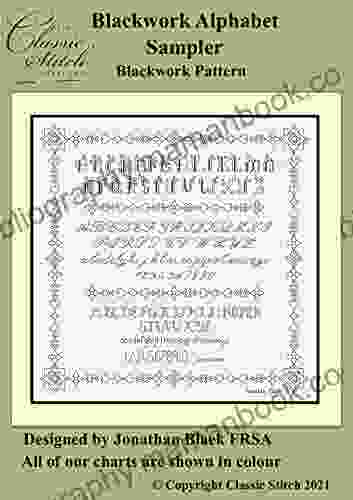The Art of Blackwork: A Comprehensive Guide to Creating Stunning Alphabets and Samplers with the Timeless Technique

5 out of 5
| Language | : | English |
| File size | : | 9460 KB |
| Print length | : | 9 pages |
| Lending | : | Enabled |
In the realm of embroidery, where threads dance upon fabric, creating intricate masterpieces, there lies a technique that stands apart with its timeless elegance and versatility: blackwork. Originating in the 16th century, blackwork has captivated needleworkers for generations, gracing everything from regal garments to delicate samplers. This article will guide you through the captivating world of blackwork, unlocking its secrets and empowering you to create stunning alphabets and samplers that will become cherished keepsakes.
A Journey Through the History of Blackwork
The roots of blackwork can be traced back to the Tudor era in England. During this period, blackwork embroidery flourished, adorning the clothing of both men and women, as well as ecclesiastical vestments and household linens. Blackwork's popularity extended beyond England, reaching across Europe and beyond. In the 17th and 18th centuries, blackwork samplers became a beloved tradition, passed down from mother to daughter, showcasing the skills and creativity of young needleworkers. These samplers, often featuring alphabets, religious motifs, and intricate patterns, serve as a testament to the enduring legacy of blackwork.
Unveiling the Techniques of Blackwork
Blackwork is characterized by its use of a single color thread, typically black, on white or light-colored fabric. The stitches employed in blackwork are simple and repetitive, yet they combine to create an astonishing array of patterns and designs. The most common stitches used in blackwork include the backstitch, running stitch, and stem stitch, each stitch contributing its own unique texture and dimension to the overall design.
The key to mastering blackwork lies in understanding the interplay between the stitches and the fabric. By varying the stitch length, spacing, and direction, needleworkers can achieve a wide range of effects, from delicate lace-like patterns to bold geometric designs. The beauty of blackwork lies in its versatility, allowing for endless creative expression and customization.
Embarking on a Blackwork Alphabet Adventure
Creating blackwork alphabets is a delightful and rewarding experience, perfect for both beginners and seasoned embroiderers. Begin by selecting an alphabet design that resonates with you, whether it be a classic serif font or a whimsical script. Transfer the design onto your fabric using a light source or tracing paper.
Using a single strand of black embroidery floss, start stitching your alphabet, carefully following the pattern. The backstitch is a popular choice for blackwork alphabets, as it creates a clean and precise line. For added depth and texture, try incorporating other stitches, such as the running stitch or stem stitch, into your design.
As you stitch each letter, pay attention to the spacing and tension of your stitches. Consistent stitch length and spacing will ensure a polished and professional-looking alphabet. Don't be afraid to experiment with different stitch combinations to create unique and eye-catching effects.
Exploring the Realm of Blackwork Samplers
Blackwork samplers offer a boundless canvas for creativity, allowing you to showcase your skills and design your own unique masterpiece. Begin by gathering inspiration from historical samplers, Pinterest boards, or your own imagination. Sketch out a design that incorporates a combination of alphabets, motifs, and patterns.
Start stitching your sampler by dividing it into sections, focusing on one area at a time. This will help you stay organized and prevent feeling overwhelmed by the larger project. Use a variety of stitches and techniques to create depth and interest, experimenting with different stitch lengths, spacing, and thread colors.
As you progress with your sampler, don't be afraid to make adjustments to your design as needed. The beauty of blackwork lies in its adaptability, allowing you to customize your sampler to reflect your personal style and preferences.
Preserving Your Blackwork Masterpieces
Once you have completed your blackwork alphabet or sampler, it's essential to take proper care of your creation to ensure its longevity. Begin by washing the embroidery gently by hand or on a delicate machine cycle. Use a mild detergent and avoid using bleach or fabric softeners.
After washing, lay your embroidery flat to dry on a clean towel. Avoid hanging your embroidery, as this can stretch the fabric and damage the stitches. Once dry, iron your embroidery on a low heat setting to remove any wrinkles or creases.
To protect your blackwork masterpiece from dust and fading, frame it using acid-free materials. Choose a frame that complements the design and enhances its beauty. Display your framed embroidery in a location where it can be enjoyed and admired for years to come.
The art of blackwork is a timeless
5 out of 5
| Language | : | English |
| File size | : | 9460 KB |
| Print length | : | 9 pages |
| Lending | : | Enabled |
Do you want to contribute by writing guest posts on this blog?
Please contact us and send us a resume of previous articles that you have written.
 Top Book
Top Book Novel
Novel Fiction
Fiction Nonfiction
Nonfiction Literature
Literature Paperback
Paperback Hardcover
Hardcover E-book
E-book Audiobook
Audiobook Bestseller
Bestseller Classic
Classic Mystery
Mystery Thriller
Thriller Romance
Romance Fantasy
Fantasy Science Fiction
Science Fiction Biography
Biography Memoir
Memoir Autobiography
Autobiography Poetry
Poetry Drama
Drama Historical Fiction
Historical Fiction Self-help
Self-help Young Adult
Young Adult Childrens Books
Childrens Books Graphic Novel
Graphic Novel Anthology
Anthology Series
Series Encyclopedia
Encyclopedia Reference
Reference Guidebook
Guidebook Textbook
Textbook Workbook
Workbook Journal
Journal Diary
Diary Manuscript
Manuscript Folio
Folio Pulp Fiction
Pulp Fiction Short Stories
Short Stories Fairy Tales
Fairy Tales Fables
Fables Mythology
Mythology Philosophy
Philosophy Religion
Religion Spirituality
Spirituality Essays
Essays Critique
Critique Commentary
Commentary Glossary
Glossary Bibliography
Bibliography Index
Index Table of Contents
Table of Contents Preface
Preface Introduction
Introduction Foreword
Foreword Afterword
Afterword Appendices
Appendices Annotations
Annotations Footnotes
Footnotes Epilogue
Epilogue Prologue
Prologue Keith Whitaker
Keith Whitaker Benjamin Law
Benjamin Law Alexander Soifer
Alexander Soifer Michael C Bailey
Michael C Bailey Joe Hart
Joe Hart Frankie Calkins
Frankie Calkins Adam Clay
Adam Clay Tim Flanagan
Tim Flanagan Nela Collins
Nela Collins Grace Goodwin
Grace Goodwin Amy Ratcliffe
Amy Ratcliffe Lauren Barnes
Lauren Barnes Mike Valasek
Mike Valasek Lee A Westberry
Lee A Westberry Eiichiro Oda
Eiichiro Oda Krissyann Granger
Krissyann Granger Vic Dimartino
Vic Dimartino Kimberly Krey
Kimberly Krey Marion Todd
Marion Todd Robin Mctaggart
Robin Mctaggart
Light bulbAdvertise smarter! Our strategic ad space ensures maximum exposure. Reserve your spot today!

 Lord ByronUnveiling the Resilient Cu Chi Tunnels: A Captivating Journey into Vietnam's...
Lord ByronUnveiling the Resilient Cu Chi Tunnels: A Captivating Journey into Vietnam's...
 Derek CookSpy and Count Christmas: A Tale of Espionage and Intrigue Amidst the Festive...
Derek CookSpy and Count Christmas: A Tale of Espionage and Intrigue Amidst the Festive... Howard BlairFollow ·15.6k
Howard BlairFollow ·15.6k Allen ParkerFollow ·17.7k
Allen ParkerFollow ·17.7k Caleb LongFollow ·14.7k
Caleb LongFollow ·14.7k Bobby HowardFollow ·9.6k
Bobby HowardFollow ·9.6k Lord ByronFollow ·8.7k
Lord ByronFollow ·8.7k Ryan FosterFollow ·9k
Ryan FosterFollow ·9k John ParkerFollow ·4k
John ParkerFollow ·4k Herbert CoxFollow ·3.9k
Herbert CoxFollow ·3.9k

 Patrick Rothfuss
Patrick RothfussHow to Make a Million Dollars: No Secrets
Making a million dollars...

 Robert Heinlein
Robert HeinleinResponse to Intervention, Second Edition: RTI in Practice
A Comprehensive Resource for Educators and...

 Timothy Ward
Timothy WardUnravel the Gripping Assassination Thriller Bursting with...
Prepare yourself for a...
5 out of 5
| Language | : | English |
| File size | : | 9460 KB |
| Print length | : | 9 pages |
| Lending | : | Enabled |














